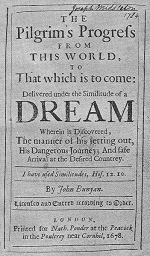< Previous |
Index |
Next > |
The Pilgrim's Progress
Welcome, traveller, to John Bunyan’s The Pilgrim’s Progress — the 17th-century mega-hit that turned spiritual struggle into a full-blown fantasy quest, complete with perilous swamps, shady cities, talking giants, and characters with names so on-the-nose you'd think Bunyan wrote it during a sermon and a fever dream.
Meet Christian, our humble hero. He's just your average man living in the City of Destruction (which, admittedly, has terrible property values), when he decides to flee the sinful life, guided only by a book, a mysterious evangelist, and an impressively persistent sense of guilt.
What follows is part religious allegory, part spiritual obstacle course, and part unintentional comedy, as Christian encounters:
- Mr Worldly Wiseman, who sounds helpful but probably has shares in Hell;
- Faithful and Hopeful, walking moral support groups;
- The terrifying Giant Despair, who runs a holiday home called Doubting Castle;
- And Vanity Fair, which is not the fashion magazine of the same name, but more like a spiritual trap with bad influencers and eternal consequences.
Along the way, Christian loses his burden (a massive metaphor strapped to his back), gains companions, and learns valuable lessons like: don’t take shortcuts through evil territory, don’t trust anyone named Talkative, and when someone named Apollyon shows up, maybe turn around quietly.
Written by John Bunyan, a preacher who penned this masterpiece from prison (possibly while being heckled by rats), The Pilgrim’s Progress has inspired millions — partly with its message of salvation, and partly because readers are determined to understand what, exactly, a "Slough of Despond" is and whether you can get wellies for it.
So grab your staff, don your metaphorical armour, and prepare for a journey of faith, trials, and alarmingly literal names. This isn’t just a book — it’s a roadmap to salvation, with detours for dragons, despair, and the occasional smug allegorical aside.
The Pilgrim's Progress was written between 1675 and 1684 by Englishman John Bunyan. It is understood that he wrote each of the two parts at different time, but they form a continuous narrative. Unlike conventional stories, it is not divided into chapters.
The original spelling, grammar and punctuation have been retained, as we see in this first edition title page that reads:
Contents
Foreword
Pilgrim's Progress is a Christian literature classic. It is a spiritual allegory that has been enjoyed by readers for over three centuries.
It was written between 1675 and 1684 by Englishman John Bunyan in two parts, the first of which tells of 'Christian' and his journey to the Celestial City (heaven). The second part relates the same journey taken by his wife Christiana and their children. These two parts form a unified whole, which become an allegory of the Christian's struggle through life.
The spiritual significance of the depictions in the story are not difficult to understand for readers of all ages.
The shrewd choice of language to describe the author's feelings is a delight. In addition, the quaint form of spelling (by later standards; 'bad' English) matches Bunyan's unashamed derision of the bad guys in the story, such as Beelzebub and Apollyon, plus a whole babble of undesirables, such as Obstinate, Hypocrisy, Envy, and so on. The atheists even have their own page.
The author pulls no punches in his dislike of other faiths: Islam, Roman Catholicism and Paganism. For example, the derogatory remarks about the 'Turk' in Talkative; Catholics in Vanity Fair; and the pope is lumped together with Pagans in The valley of the Shadow of Death.
So enjoy these pages, as innumerable others have. Click the tabs for each 'next page' in turn, and refer to the directory tabs of 'characters' and 'places' whenever required.
| privacy policy | © seiyaku |
